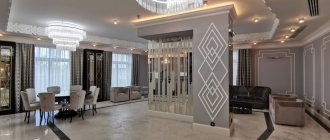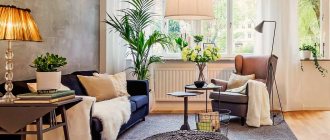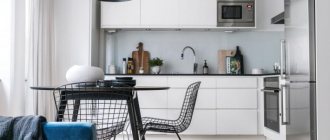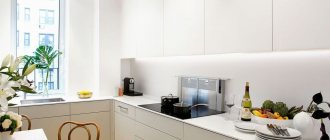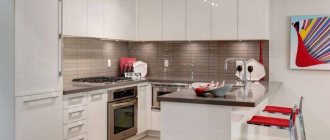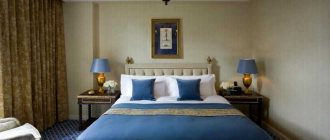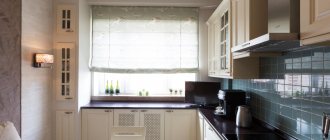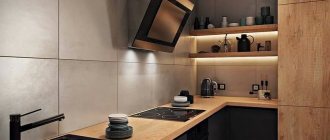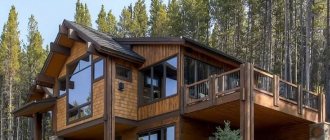The role of a kitchen apron is underestimated:
Due to the small area, it is possible to make an apron a cool accent without spending a lot of money on it.
The 2 most modern options for a backsplash are tiles and glass. But we will analyze the pros and cons of all materials.
I won’t remind you about this anymore, but take into account the size of the kitchen and the resulting density of objects. The smaller the area, the greater the concentration of kitchen utensils, and the fewer details there should be on the apron itself (i.e., without patterns, colors, etc.).
What is plywood?
To put it simply, plywood is many layers of thin wood that are glued together, as a result we get a material of greater thickness.
You will say why this is necessary, take boards or a furniture board and that’s it. But the use of such materials has disadvantages. Wood reacts to environmental changes and especially to humidity. In humid conditions, wood accepts moisture and expands. When it becomes dry, moisture leaves the wood and the board dries out, its width and thickness change.
Plywood does not have these problems; thin layers of wood are glued at 90 degree angles to each other, which gives the plywood dimensional stability and equal strength in all directions.
| Rice. 2. Layers of plywood |
In addition to plywood consisting only of layers of thin wood, there is plywood with a core of other materials, such as MDF or composite materials.
| Rice. 3. Various types of internal plywood “filling” |
Provence
The interior in the style of the French province creates home comfort and atmosphere. This solution is an excellent option not only for a country cottage, it looks great in city apartments.
Wooden countertop in a white kitchen decorated in Provence style Source www.dizainvfoto.ru
Interesting! Properly designed, it will evoke a sea breeze, interspersed with the aromas of lavender petals, Provençal herbs and ripe vineyards.
A wooden countertop in the interior of a white kitchen in Provence style is created taking into account several factors:
- Only muted shades of light natural tones are used.
- Extravagance is achieved by adding a bright accent (curtains or shelves for souvenirs). This decorative element should be made of natural material; if it can be “aged” or you can choose an element with scuffs or scratches, that’s great. This will further strengthen the hint of belonging to Provence.
- The material of the kitchen set is natural wood or MDF with a matte finish. Gloss, plastic or chipboard are unacceptable here.
- Wicker baskets are an excellent solution for storing small items. From a functional point of view, they can advantageously replace drawers.
Healthy! A cupboard with glass doors will further enhance the effect and style.
Color laminated plywood
Color laminated plywood is made by pressing special paper impregnated with resin onto hardwood plywood under high pressure and at high temperature. The result is a material with new performance properties and appearance.
| Rice. 4. Colored plywood |
Depending on the texture of the film used for laminating plywood, the following types of colored plywood are distinguished: W - embossed, mesh; F - smooth, glossy; SP - paper.
Determining the dimensions of the structure
First you need to decide on the size of the surface that will be covered with the appropriate material.
Often the height varies from 40 cm to 80 cm and above, the length depends on the length of the table, the working surface on which the cooking process takes place (the wall behind the gas stove is also protected with an apron to the height of the hood installation). Usually ranges from 1 m to 2 m.
When making calculations, individual characteristics are taken into account: the amount of furniture and its location, the height of the housewife for whom the set is built, the presence of windows and illumination (this is necessary for selecting additional lighting systems).
The final dimensions are set with a margin of 5-10 cm around the perimeter, taking into account that the apron will go behind the cabinet, table, or stove.
Brushed plywood in furniture design
Another interesting use of plywood that is worth mentioning is the work of designers from the Japanese studio Schemata Architecture Office. The Japanese presented a collection of plywood furniture called ColoRing. The furniture, to be honest, is clumsy, but the result of the unusual coloring of the plywood is interesting.
| Rice. 5. Brushed plywood |
For finishing plywood, a technology called Udukuri was used, which is known to us under the more familiar name brushing . The essence of the technology is that soft fibers are selected from the top layer of plywood with a special brush, resulting in a surface with a pronounced structure of growth rings. This treatment allows, for example, the main part of the plywood to be painted in one color, and the exposed pores in another.
| Rice. 6. Brushed plywood in furniture design |
Material and texture of facades
A white kitchen can be matte or glossy, in a modern or classic style.
In a perfectly clean new kitchen, matte looks cooler, but there is a problem - it will never be perfectly clean. Never . The slightest touch and fingerprinting can be carried out from several meters. This applies not only to the kitchen and not only to white; with dark colors things are even worse. I took a chance and made a gray matte cabinet in the hallway. In short, I learned to open and close only by the handle. You still have to wash it because... You can’t accustom guests.
All matte, uniform textures are impractical. Gloss - the lighter, the more practical.
The basis of external white facades for modern styles is always MDF. The covering of kitchen facades can be:
- Dye
- Acrylic
- Plastic
- Film
The main external difference is the edge. Painted facades do not have it at all, while others have it to varying degrees of visibility. Considering the significant differences in price, I don’t recommend bothering with it. Believe me, in a couple of months you won’t remember or notice about it. Read more in the material: How to choose a kitchen.
There may also be differences in resistance to temperature and moisture (the film suffers), but this also depends on the manufacturer, so it’s better to check where you will order the kitchen.
For classics, solid wood is added under white enamel, often with milling.
There are options to make the top of the kitchen one color and the bottom another. In an article about the design of a small kitchen, I wrote that you need to do it up to the ceiling. And there is a cool option: white bottom, wooden middle, white cabinets to the ceiling . This is a classic combination and it looks very cool.
FC plywood for furniture production
In the assortment of plywood on the Russian market, the most suitable type of plywood is FC plywood .
What is FC plywood
The abbreviation FK stands for as follows: F is plywood, K is urea glue.
This plywood is non-toxic, unlike plywood, the layers of which are glued together using glue containing toxic formaldehyde resins.
Plywood has such unique properties as light weight, beautiful texture, wear resistance, and ease of processing.
How to install a kitchen plinth?
You can install kitchen plinths yourself. The process is not difficult if you approach the matter thoughtfully and without unnecessary fuss.
Procedure:
- Check the presence of all elements of the kitchen molding in the required quantity and tools: whips, corner, end and joining elements (if necessary), sealant, fasteners (screws or nails), tape measure, pencil, hacksaw or miter saw, screwdriver (if installed on self-tapping screws) , hammer (if installed on nails), sealant gun.
- Measure the required length of the plinth, taking into account the joining and end elements.
- Cut to the required length. The rule here is: measure seven times, cut once. The extra 10mm can be cut off, but it will not be possible to increase it.
- Apply sealant to the joint between the countertop and the apron.
- Install the side on the sealant and secure it using a suitable method: screws, nails, staples, etc. It is important that when fixing the baseboard, it must fit snugly to the countertop and wall.
- Similarly, assemble the side along the entire length of the kitchen and install corner, end and connecting elements.
Photos of kitchens using plywood
Plywood for making kitchens is used both in its “pure” form, that is, with minimal finishing and preserving the natural texture, and it is also painted and tinted, and sometimes in unexpected colors.
| Rice. 10-14. Photos of kitchens using plywood |
Interesting details when making kitchens from plywood
I think you will be interested if we pay attention to the details, individual elements of the plywood kitchen .
The first thing we see is that both the body and the facades of the kitchen are made of plywood. The handles on the cabinets are in the form of through holes, and on the cabinets they are in the form of a U-shaped milling.
| Rice. 15-17. Kitchen body and facades made of plywood |
| Rice. 18-21. U-shaped milling on facades instead of handles |
The handle on plywood facades can also be made in the form of a so-called integrated handle. The handle is a milling of a recess in the edge of the facade; such a recess allows you to open the facade with your fingers.
| Rice. 22. Integrated handle on plywood fronts |
| Rice. 23. Sliding doors made of plywood |
| Rice. 24. Milling a hole in the facade instead of a handle |
| Rice. 25. Mating of plywood body parts at an angle of 45 degrees |
| Rice. 26. Mating of body parts through a milled groove |
| Rice. 27-28. Connecting the drawer parts to each other and to the facade |
Classic
The commitment to the classic style has remained unchanged for several decades. The interior of a white kitchen with a wooden countertop, designed in light colors with the presence of multi-color compositions, will remain popular for a long time. To create it, you will need to comply with a number of conditions:
- The furniture is in a classic style, made from natural materials. Imitation of wood in the form of MDF is allowed, but only high-quality, recreating the beauty of natural wood.
- Lines and shapes are strict, geometric.
- The colors are natural, pure, without gloss.
- The tabletop is wooden, without restrictions in color and texture, ranging from bleached oak to dark wenge.
White corner kitchen in a classic style Source design-homes.ru
White kitchen in a classic style with a wooden countertop Source www.polka.life
Classic white kitchen with a natural wood countertop Source www.polka.life
Important! When designing a style, you need to understand that classic means high-quality furniture created for several generations of heirs. Therefore, with all its appearance it must show quality and reliability.
See also: Catalog of companies that specialize in interior redevelopment.
OSB furniture
Along with furniture made of plywood, in the expanses of the burzhunet you can also find a completely unusual, at least for me, use of OSB for the manufacture of furniture .
Indeed, it looks unusual - a textured OSB surface combined with modern materials. But one thing remains unclear: how safe this material is for health. Obviously, it is necessary to select OSB with minimal emissions of dangerous formaldehyde and other toxic resins.
12 options for a kitchen apron made from scrap materials are very affordable, easy and fast! They're all simple, cheap and can be made (or removed) in literally minutes, making them ideal for renters or anyone looking to change up their kitchen splashback.
So let’s look at what to make a kitchen apron from and what materials are used for installation.
Stage six: filling cracks
Once the first coat of paint has dried, it's time to work on the gaps between the pieces of plywood. Of course, you can sheathe the wall without leaving any gaps. But in this case, the wall was not level, so it was impossible to place the boards end to end.
As a rule, when filling cracks, a spatula is used. But in this case it is much more convenient to work with a soft squeegee. This tool does not harm the freshly painted surface and perfectly removes excess putty that appears above the crack.
Perforated panels
Such panels allow you to conveniently place the necessary kitchen utensils, hanging them in any place on the wall you choose.
- you need to attach the panels to the walls,
- and then insert hooks from the hardware store into the holes, and their location can be constantly changed depending on your needs.
Apron made of paper or card
Look how wonderfully an apron made from a glued-on world map combines with white kitchen furniture. A really easy way to make your kitchen original! How to do:
- Cut a thin piece of plywood to the exact size of the wall, glue paper on top,
- and then apply varnish (so that the paper does not get wet from moisture and steam in the kitchen).
- Once dry, attach the plywood to the wall.
They used cards here, but you could use wrapping paper, comic books, magazine covers, anything like that.
You can attach frequently used recipes to the kitchen wall , this will save you from having to look for them when needed, and will add an interesting touch to your kitchen design. You can also attach your favorite quotes or poems.
Painting with stencils
Painting is a quick and easy way to update a kitchen wall. You can paint it in one or more colors. The last option is convenient and easy to implement using stencils. With their help, you can make a beautiful pattern or inscription, creating your own style.
For example, here the wall was painted black, and then the inscription was applied in white using a stencil.
You can also create geometric patterns. Moreover, in this case, you can make the stencil yourself using masking tape.
Master class on how to make patterns and drawings on the walls
And another option for stencil painting:
Also, painted walls can be decorated with additional decorative elements. For example, this kitchen apron was painted using stencils, and then hearts were glued on top, which go wonderfully with the chosen pattern:
Love the tile pattern but don't want to bother laying the tile? Then try options to imitate it. For example, here is a wonderful example of painted white tiles. All you need is paint and precise markings of the wall.
Apron made of wood or MDF
Wood planks add a touch of rustic style. To make such an apron, you will need a thin piece of plywood exactly the size of the wall. All the boards are cut to the required length and attached to the plywood, and then the whole thing is screwed to the wall.
How to do it yourself:
- To create such an apron, wooden boards were painted white,
- and then cut into equal pieces (the size of tiles).
- After this, all the “tiles” are attached to a thin piece of plywood that is the size of the wall, and then the plywood is attached to the wall.
Boards can be laid out to create different geometric shapes. For example, here is a zigzag made of boards painted white. Of course, in this case, you need to clearly mark the wall so that all the pieces fit together well.
And one more example of using boards. Here we took ordinary untreated wooden boards, attached them horizontally to the wall, and this is what came out of it!
How to age wood - a detailed master class
Tile
Create a mosaic backsplash with your own design using small tiles in different colors. For example, in this case, dark brown floor tiles were needed.
You can also create a mosaic pattern by breaking large tiles into smaller pieces before attaching them to the wall. The result is similar to the previous one, but more chaotic, without clear lines.
If you like more formal shapes and colors, then pay attention to this combination of small tiles in white, brown and gray:
When using very small tiles, it seems that the colors transform into each other and shimmer. In the example in the photo, a dark color scheme was chosen, but with such tiles you can experiment with even the brightest colors.
The shape of the tile has a great influence on the result, for example, taking a hexagonal tile instead of a square one immediately achieves an original effect. It is especially good to take hexagonal tiles, which have some color transitions, like here from white to gray:
Using tiles you can achieve a 3D effect. To do this, lay the tiles not side by side at the joint, but overlapping each other, creating volume. For example, like in this case:
Mosaic apron made from old dishes
Broken dishes are a kind of homemade tiles. Laying a kitchen apron and the result are similar, only you don’t need to buy the material, because it is used for dishes that you haven’t used for a long time and have finally found a new use.
And one more option for using this method, and here the result is similar to a painting of modern art. Beautiful and impressive!
How to make a mosaic yourself - watch the master class
Stone apron
A kitchen apron made of stone will help create a rustic style and will be a wonderful addition to the interior.
Do you constantly collect pebbles on the beach? Or maybe there are a lot of them in your garden? Then look at one of the options for using them. It looks like mosaic masonry, beautiful and original!
HPL plastic
The simplest option from an economic point of view. Chipboard board covered with imitation natural wood - laminated plastic using postforming technology. Such a tabletop repeats not only the pattern of wood fibers, but also their texture, and costs 3-4 times less.
The surface does not require regular maintenance, like wooden or veneered countertops. It is glued using a similar technology of high-quality vacuum pressing. It has disadvantages similar to veneer products: it cannot be sanded, and if the decorative protective layer of plastic is damaged, the entire structure of the chipboard is destroyed.
An example of a plastic countertop in the interior of a white kitchen Source pinimg.com
White kitchen in Scandinavian style Source homify.com
Healthy! Prices for laminated countertops in the catalogs of one of the largest retailers of finishing materials in Moscow and Moscow Region start from 2,550 rubles. The cost of a board of similar size made of solid beech starts from 9,890 rubles.

